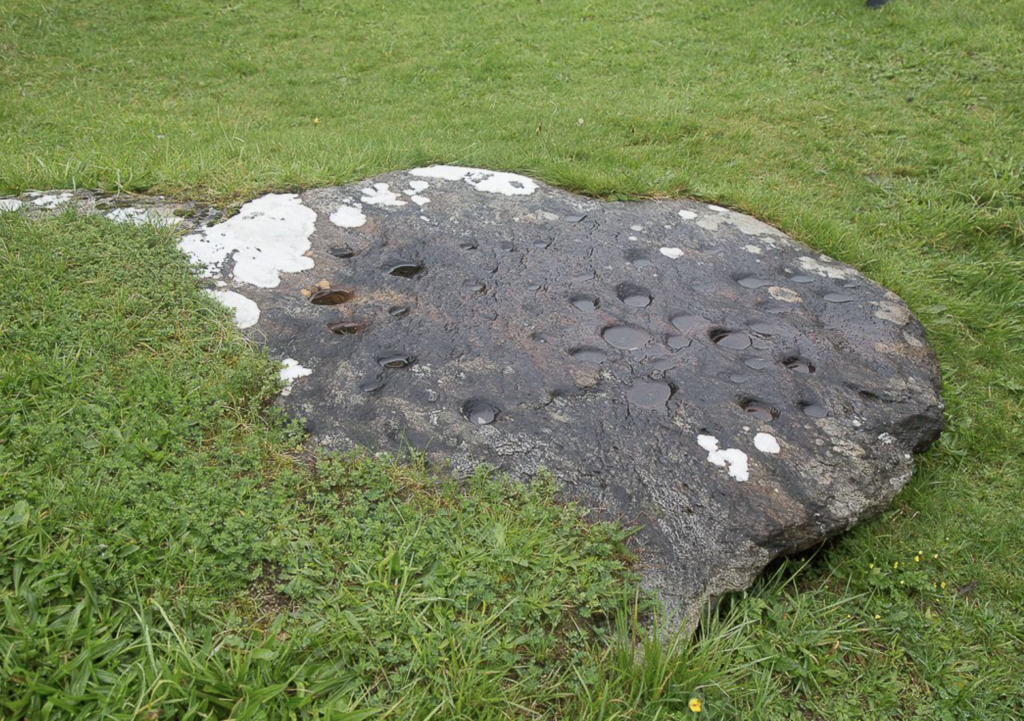
Lay Your Troubles Down on the Stone of Sorrows at Lacknacoo
Wouldn’t it be great to dump your sorrows somewhere, or cast your worries off onto a rock you could leave behind?
A flagstone dotted with ancient circular cup markings dating back thousands of years rests, half-buried on a hillside in Lacknacoo, and locals are venerating and laying down their worries still. The stone tops a small mound surrounded by a U-shaped circle of other stones. It is known as the Stone of Sorrows.
Lacknacoo is a small rural townland in Gartan, County Donegal, Ireland, notable for its rich natural beauty and cultural heritage. The area is steeped in history, reflecting the broader historical narrative of County Donegal. Next to the stone is a giant Celtic Cross. Similar juxtapositions of symbols of the “old” and the “new religions appear throughout Ireland.

The stone is obviously ancient, with its carvings and cupmarks dating from the pagan times, and the cross marks the transition to the new religion – Christianity.
Gartan is the birthplace of a prominent Christian and one of Ireland’s most revered patron saints. St. Columba – aka St. Colmcille- was born in 521 AD, not far from the hillside of the two monuments. Columba founded numerous monasteries – including Iona in Scotland- and is credited with converting the Picts in northern Scotland.
STONE OF WORRIES – STONE OF SORROWS
Many stories are associated with the stone. It is known as the Lead na Cumha – or the Stone of Sorrows. One story states that an old, lonely man who had lost most of his family and friends was so sad that he wanted to take his own life. Seeing this, St. Colmcille led the old man to this flagstone and gave him some water to drink from the stone. After drinking the water, the old man’s sorrows no longer weighed heavily on his heart, and he left cured of his depression. After that, people came from all around to lay their sorrows at the stone and be healed.

People still come today and lay their sorrows, worries, and loneliness on this old flagstone. There is a local tradition of walking clockwise around the circle of stones that elevates the Stone of Sorrows, chanting prayers and meditating on the sorrows you wish to lay down onto the stone.
Many pilgrims will leave tokens – coins, feathers, crosses, crystals, other stones – as mark of devotion and gratitude.

The view from the Stone of Worries is vast. It overlooks the surrounding hills and boglands, which are said to be the dwelling places of the fairy folk (People of the Sí).
Fairy rings—circular formations in grass or mushrooms—were / are believed to be portals to their realm. Disturbing these sites was thought to bring bad luck or even the wrath of the fairies.
Fairy Lights: On rare occasions, locals reported seeing strange, dancing lights in the bogs. These were interpreted as fairy lights, possibly leading travelers astray.

The energy at the site of the Stone of Sorrows is palpable. One loses track of time. It’s a thin place.
The Stone of Worries
(Lacknacoo, County Donegal)
In the wild Donegal wind, the heather bends low,
And the bog holds secrets the rivers still know.
There lies a stone, old as sorrow, they say,
Where hearts come to lighten and leave what won’t stay.
Each hand that has touched it left more than a trace,
A burden unspoken, a sin, or a face.
The hollow is deep from the tears that it’s known—
The grief of a people made part of the stone.
No priest hears confession, no psalm needs be read,
The granite remembers the prayers of the dead.
You whisper your troubles, the stone hears it all,
Then carries the weight so you needn’t fall.
When mist curls like smoke on the mountain’s gray crown,
And the lark’s lonely song drifts gently down,
Walk to Lacknacoo with your heart open wide—
The stone will hold sorrow; you’ll leave with your pride.
For long as the wind sings through Donegal’s moor,
The Stone of Worries will carry one more.

Leave a Reply